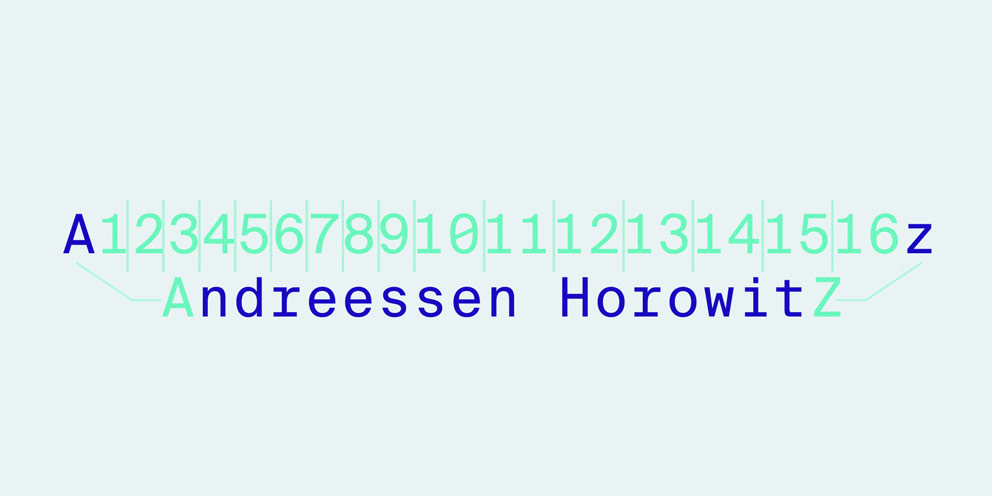A16z stands for Andreesen Horowitz.
A16z is a venture capital fund that invests heavily in cryptocurrency projects.
A16z was founded by Marc Andreessen and Ben Horowitz back in 2009.
On May 25th, the company announced a new $4.5 billion fund to support crypto and blockchain companies.
Their investments to date include popular NFT platforms OpenSea and The Foundation, as well as Coinbase.
Venture firms like a16z are able to invest large amounts of money into new projects early on, meaning they can reap profits when it goes public and can sell off tokens before the project crashes.
Even though they’ve invested in successful products, they’ve also invested in tokens that crashed immediately at launch.
This list will specifically focus on Altcoins and DeFi protocols that a16z has invested in.
Note: this is in no way an endorsement of the a16z portfolio or the assets listed here – it’s strictly for information.

a16z is a numeronym that represents Andreessen Horowitz. In this case, the first and last letter of the partners (AZ) with the character count (16) in-between.
The a16z list:
- Avalanche (AVAX)
- Celo (CELO)
- Chia (XCH)
- Dapper (FLOW)
- Internet Computer Protocol (ICP)
- Diem
- NEAR Protocol (NEAR)
- Solana (SOL)
- Uniswap (UNI)
- Protocol Labs (IPFS and FIL)
A16z — 10 Major Crypto Investments:
1
Ava Labs – Avalanche (AVAX)
Avalanche is a proof of stake blockchain purported to run faster, and scale better than Ethereum.
As one of many so-called Ethereum killers, AVAX allows for the creation of smart contracts as well as DeFi protocols. One of the major DeFi apps on this blockchain called Wonderland became infamous because it was run by the co-founder and scammer behind QuadrigaCX, Michael Patryn.
- Price: $78.72 (April 2022)
- Total value locked in DeFi: $11 billion
- Market cap: $21 billion
- Biggest challenge: Competing with a dozen other “Ethereum-killers”
2
Celo (CELO)
Celo acts as a peer-to-peer payment network that uses a series of stablecoins to send money across borders. It uses proof of stake verification, and functions similarly to PayPal. However, CELO has some major limitations since it is not interoperable with Ethereum. That means it will struggle to scale and achieve mass adoption.
While banking the unbanked is a very admirable endeavour, CELO has not yet shown it can address the systemic issues that leave millions around the world unbanked.
- Price (as of April 20th, 2022): $3.27
- Market cap: $1.4 billion
Biggest challenge: no one is really using it (24 hour volume is around $100,000)
3
Chia (XCH)
Chia (XCH) is a so-called green cryptocurrency that uses large amounts of empty hardware storage for mining and validation. Chia mining was behind recent shortages and price spikes in HDD drives. By “harvesting” chia using this hardware, it causes them to fail much sooner. As of this moment, it is unavailable for purchase at most centralized exchanges.
- Price: $63.37 (as of April 2022)
- Market cap: $230 million
- Biggest challenge: Competing with a dozen other Ethereum-killers that are already in use and don’t destroy hardware nearly as fast
4
Dapper Labs (FLOW)
Dapper Labs (FLOW) is a blockchain company responsible for one of the earliest NFT projects, CryptoKitties.
The FLOW token secures the most profitable NFT marketplace in sports called NBA TopShot, making Dapper ridiculous profit from transaction fees.
One obvious drawback to some of these projects is that many of the NFTs cannot be taken off of a custodial wallet. As a result, purchasing NFTs gives someone “ownership” without actually allowing them to take control or custody of the asset.
- Price: $5.83 (as of April 2022)
- Market cap: $2 billion
- Biggest challenge: Convincing more sports fans to adopt their products
5
Dfinity’s Internet Computer (ICP)
Dfinity’s Internet Computer (ICP) is a project significantly less entertaining and even wholesome than the Insane Clown Posse (also ICP).
After receiving millions of dollars in funding and a listing on Coinbase, ICP debuted at more than $450 a token only to almost immediately collapse spurring rugpull allegations. If one is brave enough to venture onto their website and read all their blogs and documentation, they will still have absolutely no clue what ICP is.
- Price: $17.19 (as of April, 2022)
- Market cap: $3.8 billion
- Biggest challenge: Pumping the price again.
6
Diem
Oh no, this token is brought to you by our friend Mark Zuckerberg.
The company formerly known as Facebook wanted to expand into the crypto space by developing a stablecoin called Libra. Luckily, these attempts culminated in failure around 2019 but the project received new life after being renamed Diem.
Luckily, it looks like Facebook’s latest attempt at financial domination has failed again.
- Price: N/A
- Market cap: N/A
- Biggest challenge: N/A
7
NEAR Protocol (NEAR)
Why invest in just one so-called Ethereum killer when you can try your hand at all of them?
NEAR Protocol is another relatively new proof of stake blockchain that’s managed to reach the top 20 cryptocurrencies by market cap very quickly. However, NEAR’s governance is highly centralized as early investors and developers control roughly 30 percent of the supply.
- Price: $16.68 (April, 2022)
- Market cap: $11.2 billion
- Biggest challenge: Dealing with the other dozen or so blockchains in the space, and differentiating themselves.
8
Solana (SOL)
Solana (SOL) is purportedly the fastest blockchain around, capable of processing thousands of transactions and hosting many decentralised applications.
Recently, its price tanked after a venture capitalist named Chamath Palihapitya allegedly bought tokens at a discount, pumping up the price and then sold it.
There are also concerns that this proof of stake blockchain is heavily centralised.
- Price: $50 (May 2022)
- Market cap: $35 billion
- Total value locked in DeFi: $6.8 billion
- Biggest challenge: High congestion leads to network outages. A lot of them.
Related: What’s so Great About Solana?
9
UniSwap (UNI)
UniSwap (UNI) is one of the most popular decentralized exchanges, which also allows for a lot of DeFi activity.
The UNI token provides governance for the exchange.
Note that some cryptocurrency billionaires and insiders liken the world of DeFi yield farming to a Ponzi scheme.
“Like this is a valuable box as demonstrated by all the money that people have apparently decided should be in the box,” Sam Bankman-Fried, founder of the FTX exchange, said on a recent financial podcast. “And who are we to say that they’re wrong about that?”
When interviewers called out that his description for sounding suspiciously like a Ponzi, he said this:
“I think that’s a pretty reasonable response, but let me play around with this a little bit. Because that’s one framing of this. And I think there’s like a sort of depressing amount of validity.”
- Price: ~$5.25 (May 2022)
- Market cap: $6.3 billion
- Total value locked in DeFi: $7.43 billion
- Biggest challenge: Competing to provide better yield than newer protocols and challengers.
10
Protocol Labs: IPFS and FIL
Protocol Labs has developed interplanetary file storage (IPFS) which stores the data linked in many NFTs. However, IPFS is not user friendly and it is difficult for the average user to set up and host their node. It also uses a lot of internet bandwidth.
Protocol Labs has also developed Filecoin (FIL) to help secure permanent data storage.
- Price of FIL: $19.76 (April 2022)
- Market cap: $3.6 billion
- Biggest challenge: An overly complicated storage solution that many people don’t really want or need.
Takeaways
A16z’s picks are interesting but they don’t always translate into good investments.
It’s important that these investments aren’t viewed as an endorsement of the technical and feasible aspects of a token. Some of these like Diem and ICP have failed incredibly.
While a16z are highly influential within the crypto space, at the end of the day they’re a firm concerned with enriching themselves (often by getting in super early to things); they are not necessarily picking the best token for retail investors.






